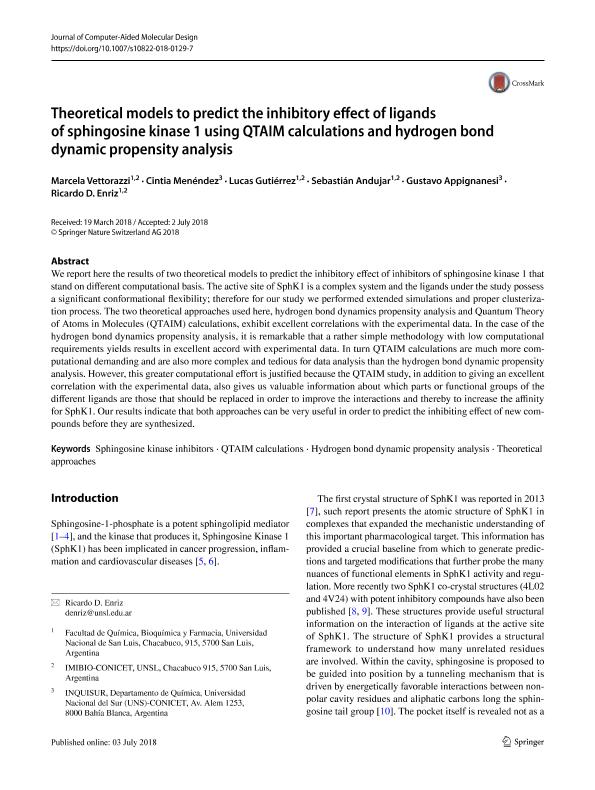Artículo
Theoretical models to predict the inhibitory effect of ligands of sphingosine kinase 1 using QTAIM calculations and hydrogen bond dynamic propensity analysis
Vettorazzi, Marcela Cristina ; Menéndez, Cintia Anabella
; Menéndez, Cintia Anabella ; Gutierrez, Lucas Joel
; Gutierrez, Lucas Joel ; Andujar, Sebastian Antonio
; Andujar, Sebastian Antonio ; Appignanesi, Gustavo Adrian
; Appignanesi, Gustavo Adrian ; Enriz, Ricardo Daniel
; Enriz, Ricardo Daniel
 ; Menéndez, Cintia Anabella
; Menéndez, Cintia Anabella ; Gutierrez, Lucas Joel
; Gutierrez, Lucas Joel ; Andujar, Sebastian Antonio
; Andujar, Sebastian Antonio ; Appignanesi, Gustavo Adrian
; Appignanesi, Gustavo Adrian ; Enriz, Ricardo Daniel
; Enriz, Ricardo Daniel
Fecha de publicación:
07/2018
Editorial:
Springer
Revista:
Journal of Computer-Aided Molecular Design
ISSN:
0920-654X
Idioma:
Inglés
Tipo de recurso:
Artículo publicado
Clasificación temática:
Resumen
We report here the results of two theoretical models to predict the inhibitory effect of inhibitors of sphingosine kinase 1 that stand on different computational basis. The active site of SphK1 is a complex system and the ligands under the study possess a significant conformational flexibility; therefore for our study we performed extended simulations and proper clusterization process. The two theoretical approaches used here, hydrogen bond dynamics propensity analysis and Quantum Theory of Atoms in Molecules (QTAIM) calculations, exhibit excellent correlations with the experimental data. In the case of the hydrogen bond dynamics propensity analysis, it is remarkable that a rather simple methodology with low computational requirements yields results in excellent accord with experimental data. In turn QTAIM calculations are much more computational demanding and are also more complex and tedious for data analysis than the hydrogen bond dynamic propensity analysis. However, this greater computational effort is justified because the QTAIM study, in addition to giving an excellent correlation with the experimental data, also gives us valuable information about which parts or functional groups of the different ligands are those that should be replaced in order to improve the interactions and thereby to increase the affinity for SphK1. Our results indicate that both approaches can be very useful in order to predict the inhibiting effect of new compounds before they are synthesized.
Archivos asociados
Licencia
Identificadores
Colecciones
Articulos(IMIBIO-SL)
Articulos de INST. MULTIDICIPLINARIO DE INV. BIO. DE SAN LUIS
Articulos de INST. MULTIDICIPLINARIO DE INV. BIO. DE SAN LUIS
Articulos(INQUISUR)
Articulos de INST.DE QUIMICA DEL SUR
Articulos de INST.DE QUIMICA DEL SUR
Citación
Vettorazzi, Marcela Cristina; Menéndez, Cintia Anabella; Gutierrez, Lucas Joel; Andujar, Sebastian Antonio; Appignanesi, Gustavo Adrian; et al.; Theoretical models to predict the inhibitory effect of ligands of sphingosine kinase 1 using QTAIM calculations and hydrogen bond dynamic propensity analysis; Springer; Journal of Computer-Aided Molecular Design; 32; 7; 7-2018; 781-791
Compartir
Altmétricas



